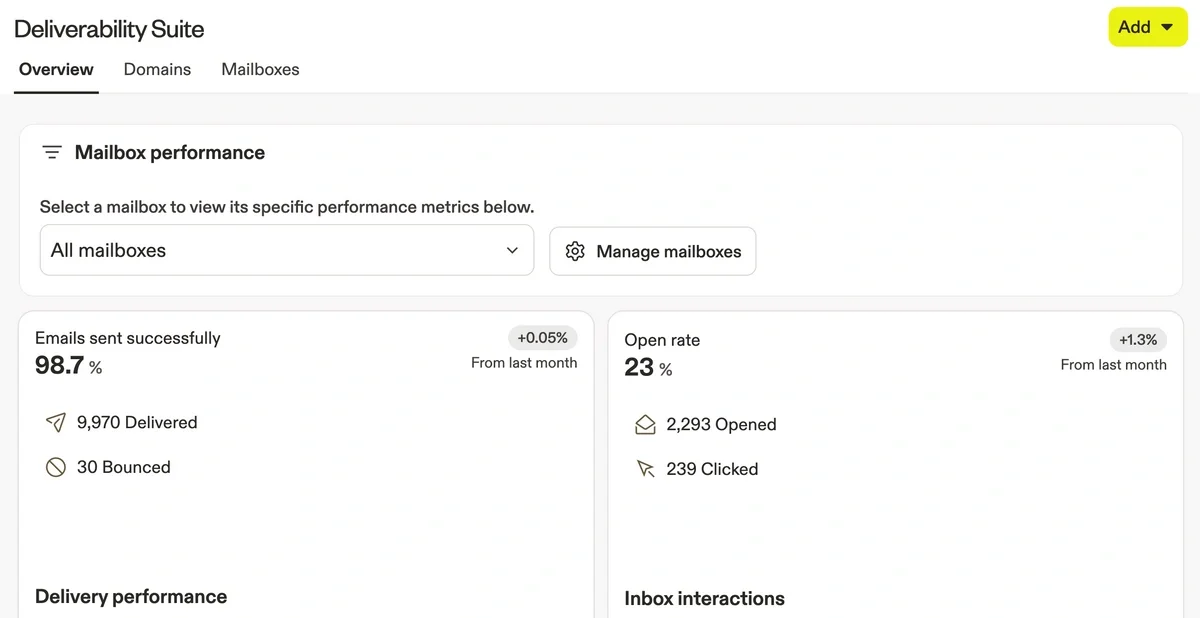How to Improve Email Deliverability and Actually Get Opens
If your emails aren’t getting opened, they might never be reaching the inbox. Learn how to improve deliverability with better authentication, warm-up, reputation monitoring, and list hygiene — plus how Apollo helps automate it all.
by
Janet Choi
PUBLISHED Feb 21, 2025
7 Min Read
UPDATED Nov 10, 2025
If your open rates are collapsing, the problem might not be your copy — it’s that your emails never land in the inbox. The harsh reality: as many as 20% of emails never make it to the inbox. They’re filtered, throttled, or vaporized before your prospect even sees them.
If you’re not proactively managing deliverability, you’re not just losing opens — you’re leaving revenue on the table.
What is email deliverability?
Email deliverability is the likelihood your emails actually hit the inbox (not the spam folder). It’s different from delivery, which only tracks if the server accepted the message.
Inbox placement is earned through sender reputation and engagement — what mailbox providers measure to decide if your message belongs in Primary, Promotions, or Spam.
In short, just landing in the inbox isn't enough. Recipients must open, click, or respond. This requires optimizing infrastructure, sender reputation, list hygiene, content, and ongoing monitoring.
5 proven ways to improve email deliverability (for sales teams)
Let’s dive into five modern tactics that focus on setup and sending health — now updated to reflect Apollo’s latest deliverability suite enhancements.
1. Authenticate every domain with SPF, DKIM, and DMARC
Email providers (Google, Microsoft, etc.) use SPF, DKIM, and DMARC to confirm your identity. If you don't set up authentication, your messages look suspicious, even if they’re legitimate.
The modern shortcut for sales teams: Apollo now lets you buy and authenticate new sending domains and mailboxes directly in-platform. No DNS headaches or IT tickets.
Each domain or mailbox comes pre-configured with authentication, giving you a clean foundation while protecting your main domain's reputation.
Pro tip: Use subdomains (like outbound.yourcompany.com) for cold outreach. Keep your primary domain safe for marketing and customer communication.
2. Warm up every new mailbox gradually
Launching a new domain or mailbox cold is like trying to sprint before stretching. You’ll pull something (your sender reputation).
Warming up fixes this by gradually building trust through small, safe send volumes.
With Apollo Email Warmup, this gradual mailbox credibility building runs automatically. The system gradually ramps send volume, simulates real engagement, and ensures your mailbox builds credibility before you start scaling outreach.
When done right, you’ll see more consistent inbox placement, not the dreaded spam folder.
3. Monitor sending health before problems hit your inbox
Most teams don’t realize something’s wrong until open rates plummet.
That’s where Apollo’s Deliverability Suite comes in. It’s a centralized command center that shows real-time health across your domains, mailboxes, and sequences.
You can instantly see:
- Which domains are authenticated and performing well
- If bounce rates or spam flags are trending upward
- When engagement metrics start slipping
Instead of guessing, you’ll know and can act fast before small issues snowball into blacklisting or reputation damage.
Learn more about Apollo’s Deliverability Suite.
4. Use custom tracking domains to protect sender reputation.
Tracking domains are used to track email engagement like clicks. Most email platforms use shared tracking domains, but if there are bad actors, everyone’s deliverability can suffer.
Custom tracking domains reduce reputation spillover and align your links with your sending domain — a consistency signal mailbox providers like.
We recommend matching custom tracking domains to the number of sending domains you’ve set up. For example, here's what this would look like with two different sending domains and four mailboxes:
5. Maintain list hygiene and content quality for better inbox placement
Even the best infrastructure fails if your contact lists and content are cluttered.
List hygiene:
- Regularly remove hard bounces, spam traps, and disengaged contacts.
- For an extra layer of email verification, run addresses through an email validation tool. Apollo’s Waterfall Enrichment allows you to check multiple data sources for an email address and then add an email validation step using tools like ZeroBounce.
- Set a clean-up cadence: weekly suppression, monthly deep-clean of low-engagement segments.
Content relevance:
- Avoid mass-sending identical messages.
- Personalize with merge tags, alternate intros, and natural tone.
- Keep HTML minimal for sales emails; plain text signals authenticity.
Relevance is the best way to avoid the spam folder. But personalizing all your messages can be time-consuming to do at scale. Watch this lesson about how to use AI to Generate Personalized Emails.
The revenue impact of better deliverability
Good deliverability isn’t just a technical win, it’s a revenue lever. When your emails consistently reach the inbox, every stage of your outbound motion improves: open rates rise, reply rates follow, and pipeline grows faster.
Yet many teams only think about deliverability when something breaks. The most successful ones treat it as a core part of their go-to-market system — continuously monitoring, optimizing, and protecting their sender reputation.
Apollo makes that easier. From domain authentication and warm-up to ongoing monitoring and list hygiene, every part of your email health lives in one place.
Ready to learn more?
- Watch our webinar on how to avoid the spam filter
- Read the Email Deliverability chapter of Apollo’s Outbound Sales book (also available on Amazon)
- Review our Email Deliverability Best Practices and 5 Deliverability Mistakes to Avoid
- Stay up to date on what's new with deliverability and more in Apollo with our monthly release notes.
Related articles
Subscribe for weekly updates
Receive insider stories and data-backed insights for elevating your work and staying ahead of the curve
You can unsubscribe at any time using the link in our emails. For more details, review our privacy policy.

